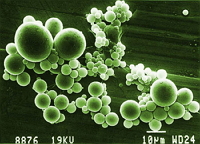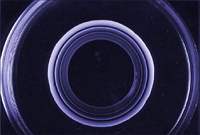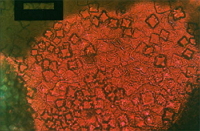CHARACTERIZATION AND PROPERTIES OF COLOIDAL AND POLYMER SYSTEMS
|
Description |
The production of biocompatible matrices for the encapsulation of active principles and subsequent transfer, is booming due to the need to find homogeneous, stable systems that have the possibility of being used with a great variety of drugs. These properties can be given in our latex microparticles and gel-like systems.
Nanoparticles have the advantage of being able to use intravenously as opposed to other colloidal, controlled release submicron systems such as liposomes. The precursor microemulsion is thermodynamically stable and transparent, which makes it easier to obtain our systems.
Gelled systems are of particular interest in the biomedical industry for the preparation of soft systems that can be used as implants, both for external and internal use. These systems have advantages in the stability and easy application, compared to the systems of traditional use. The diffusion processes in gels are innovative for their applications in the field of biosensors.
Obtaining polymorphs is involved in the two previous lines, due to the need for a control of the solubility of active principles and excipients for the preparation of the mentioned biomedical forms.
The Group of Colloids and Polymers of the Department of Pharmaceutical Physical-Chemistry of the Faculty of Pharmacy has developed a technique for characterizing colloidal systems and properties of these systems.
The group works in the encapsulation of active principles in polyacrylamide latex, preparation of mixed and simple gelling systems used as support of chemical and immunological reactions and in the identification of polymorphs.
|
How does it work |

Polyacrylamide latex microparticles loaded with the active substance sodium phosphate dexamethasone.
The research group focuses its work on the following lines:
1. Encapsulation of active ingredients in polyacrylamide latex: Preparation of latex microparticles by the concentrated emulsion polymerization method. Determination of size and structure, percentage of drug included and assignment studies. X-ray diffraction techniques, electron microscopy, differential scanning calorimetry and light scattering are used.
 Chemical reaction in agarose gel with formation of precipitates of calcium phosphate.
Chemical reaction in agarose gel with formation of precipitates of calcium phosphate.
2. Preparation of mixed and simple gelling systems used as support for chemical and immunological reactions. We have the necessary means to characterize both the gels and the sol-gel transition from their rheological behavior. For gel diffusion reactions we have methods of recording and processing images.

Recrystallization at 180 ° C of the n-alkylammonium chloride surfactant.
3. Identification of polymorphs: Characterization of stable and metastable forms of active principles and solid dosage forms by differential scanning calorimetry, optical microscopy and X-ray diffraction.
|
Advantages |
The profitability of obtaining stable, homogeneous and controlled solubility biomedical application systems is evident because it allows:
A) The reduction of production costs by:
• 1) The preparation of stock of certain active ingredients that ensure bioavailability at long shelf life.
• 2) The use of biocompatible and biodegradable products ensures a low environmental impact.
B) In relation to the distribution:
• Easy handling and application.
• A positive impact on a higher percentage of the population.
|
Where has it been developed |
The Group of Colloids and Polymers of the Department of Physics and Pharmaceutical Chemistry of the Faculty of Pharmacy has been working for more than ten years on problems related to the structure, characterization and properties of colloidal systems and polymers of biomedical interest. We have developed methods to obtain polyacrylamide particles of low polydispersity and sizes between 1 and 5 microns. In the field of the gels, we have standardized the procedure for the control of gel time as a function of pH and temperature.
|
And also |
The research group has experience in collaborations with private companies in the polymer industry.
|
Contact |
|
© Office for the Transfer of Research Results – UCM |
|
PDF Downloads |
|
Classification |
|
Responsible Researchers |
Carmen Rueda Rodríguez: crueda@farm.ucm.es
Concepción Arias García: carias@farm.ucm.es
Enrique López Cabarcos: cabarcos@ucm.es
Department: Physical and Pharmaceutical Chemistry
Faculty: Pharmacy


